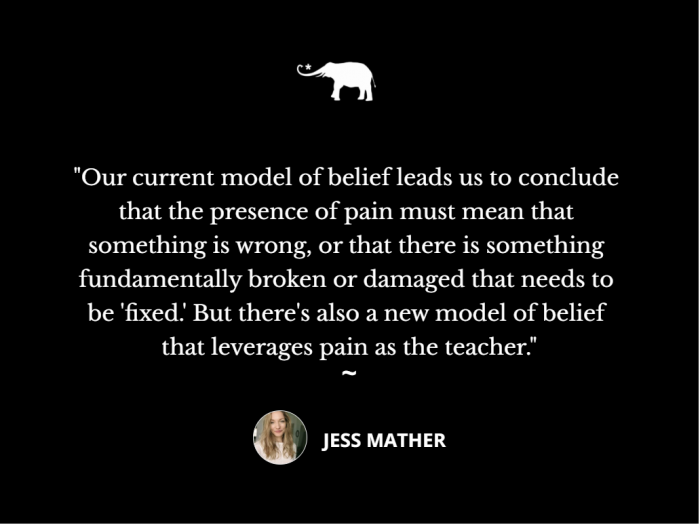What if there’s actually nothing “wrong” with your body?
If you live with chronic pain, or know somebody who does, there is often a story attached to the pain that concludes there must be something “wrong” with the body. That the body must be “damaged” now because of the pain, stress, or immobility we’re experiencing, even if there isn’t a conclusive diagnosis or cause for our symptoms.
We see doctors and therapists saying, “I don’t know what’s wrong with you. We don’t see anything wrong. We can’t help you.”
Our current model of belief leads us to conclude that the presence of pain must mean that something is wrong, or that there is something fundamentally broken or damaged that needs to be “fixed.”
But there’s also a new model of belief that leverages pain as the teacher in order to understand how we can change our environment and patterns to create a different response in the body. One highly effective route under this holistic model is addressing pain and limitation directly through movement.
With therapeutic movement, we’re addressing the physical body and the musculoskeletal system, but it isn’t because there’s necessarily a problem with that system. There may be joint or tissue damage, or there might not be. Pain can be present without structural abnormalities. Pain can also be absent with structural abnormalities.
It’s extremely important to note that there may not be anything that’s truly “damaged.” Imaging and diagnosis don’t always tell the whole story. They’re only one data point within a complex system contained within an incredibly complex human being.
Movement is an unbelievable primary tool for two reasons. One, movement gives us a means to communicate with the body and the pain response. How can we use movement to create a new response of safety in the nervous system to soothe and re-pattern the protective response of pain, stiffness, or immobility? How can we use movement as a tool to build more capacity, safety, and resilience in both a physiological and physical way?
The second reason we use movement is because bodies move. We are meant to move. Life is movement. But more often than not, chronic pain becomes exaggerated by movement. So, we move less, which we know ultimately makes our pain and health much worse. Some people even develop “kinesophobia,“ which is the fear that moving will cause pain. It’s a real experience for them.
These people want to move, they want to feel strong, pain-free, and mobile, but they’re trapped in this cycle. It’s not uncommon for chronic pain sufferers to share something similar to, “Movement, or these movements, hurts, so I won’t move. But not moving makes me worse. I feel less like myself when I can’t move well and I hurt.”
We have to establish safety, carefully and gradually, in the places where we previously have not felt safe. We have to create a visceral, repeated experience of safety in our body and in movement to destabilize the old protective pain and stress cycle.
This is how restoration happens under a holistic model of pain and strength. This is how people who are hurt, stressed, and physically limited by their conditions can restore a sense of home, safety, strength, and freedom in their body again. This is how we can get on with our lives, do cool things in the world, and kick ass in all the ways we know we’re capable of.
You are not broken. Your body is not “wrong.” You are not defined by your pain or limitations.
You are an incredible organism wired toward safety—we just have to learn how to work with our bodies and protective responses, instead of against them.
~









Read 2 comments and reply